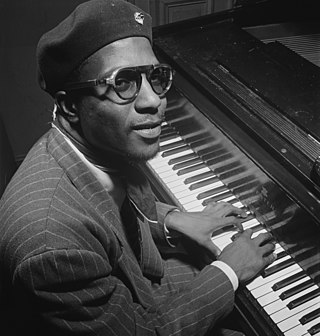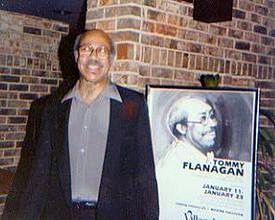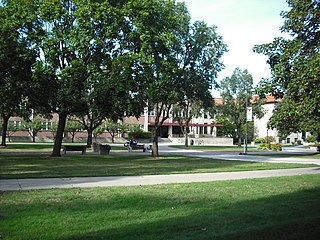
Baker's Keyboard Lounge is a jazz club located at 20510 Livernois Avenue in Detroit, Michigan. It was founded in May 1933 and is the oldest continuously operated jazz club in Detroit.

Baker's Keyboard Lounge is a jazz club located at 20510 Livernois Avenue in Detroit, Michigan. It was founded in May 1933 and is the oldest continuously operated jazz club in Detroit.
In 1933 Chris and Fannie Baker opened Baker's as a lunchtime sandwich restaurant. In 1934 their son Clarence Baker began booking jazz pianists, [1] but Baker's was still known at that time principally as a restaurant. [2] In 1939 Clarence took over ownership after Chris had suffered from a stroke. That same year, Clarence began booking pianists from outside the Detroit area, although the club featured local pianist Pat Flowers from 1940 until 1954. In 1952, the club was expanded and remodeled to the Art Deco look that it retains today. By 1954, the business had rapidly expanded, and by the following year, Baker's began featuring major jazz acts, notably Art Tatum who played the last two years of his life, Dave Brubeck in 1957 and Gerry Mulligan in 1958. [2] During the 1950s "modern" jazz was less common at Baker's than it was in the 1960s, when the emphasis of the club's music changed to Hard Bop. [2] During the 1960s Clarence leased the club out, but resumed personal control in the 1970s. [1]
Baker's is noted for its long history of presenting local and major jazz acts, its excellent acoustics, its intimacy – seating only 99, its Art Deco furnishings, including a distinctive, piano-shaped bar painted with a keyboard motif, Art Deco style paintings of European city landscapes by Harry Julian Carew, tilted mirrors that allow patrons to view the pianist's hands, [2] and its Steinway piano which was selected and purchased in New York by Tatum for Clarence in the 1950s. [3] The club still displays its original liquor pricelist from 1934, showing the price of beer at 26 cents. [4]
In 1986, Baker's was designated as an Historic Site by the Michigan State Historic Preservation Office. The historic significance of the site is stated as follows:
Baker's Keyboard Lounge has significance as Michigan's jazz mecca and Detroit's oldest jazz club in continuous operation. Founded in May 1933 by Chris Baker as a restaurant and piano bar, the present jazz orientation of the club has been firmly in place since 1939. Baker's Keyboard Lounge has hosted the greatest names in blues and jazz since that date. Some of the musicians who have played the club include: Ella Fitzgerald, Miles Davis, Oscar Peterson, George Shearing, Sarah Vaughn, Joe Williams, Maynard Ferguson, Cab Calloway, Woody Herman, Modern Jazz Quartet, and Nat "King" Cole; to name but a few. In 1984, Baker's Keyboard Lounge celebrated fifty-years of the sound of jazz in Detroit and Michigan. [5]
The popularity of the club declined in the 1970s and 1980s, and was nearly closed on several occasions. In 1996, after owning the club for 57 years, Clarence Baker sold the club to John Colbert and Juanita Jackson. The new owners were challenged by declining interests in live jazz performances, due to the aging of the fanbase of jazz purists, a shift to mainstream jazz from the historic Hard Bop emphasis of the club, and the popularity of hip hop. The new ownership attempted to compensate with fundraisers, a reduction in bookings of nationally known acts and emphasis on local artists, and diversifying the lineup to include R&B and comedy acts. [6] The club experienced a resurgence in popularity, but the downturn in the economy led Colbert to declare bankruptcy in 2010, leading to widespread speculation that the club would finally close. In 2011, the club was purchased at a bankruptcy sale, by Hugh W. Smith III, who had been manager of the club for the previous two years and Eric Whitaker Sr. Smith and Whitaker vowed to keep Baker's open as a jazz club. [1] [3]
In 2016, The Detroit City Council approved an ordinance to establish the Baker's Keyboard Lounge Historic District, a designation that prevents whoever owns the building from demolishing it or altering its exterior without permission from the Detroit Historic District Commission. [7]
With the economic and cultural resurgence of Detroit, Baker's is again receiving notable media coverage. [8]

Many famous musicians, especially jazz musicians, have played in the club during its history, such as Louis Armstrong, John Coltrane, Oscar Peterson, Fats Waller, Wes Montgomery, [9] Meade Lux, Erroll Garner, Art Tatum, Pat Flowers, Nat King Cole, Ella Fitzgerald, Tommy Flanagan, George Shearing, Chet Baker, Gerry Mulligan, Cab Calloway, Betty Carter, Eddie Jefferson, Kai Winding, the Modern Jazz Quartet, Sonny Stitt, Kenny Burrell, Barry Harris, Donald Byrd, Earl Klugh, Pepper Adams, and Miles Davis have all performed at the club. [2] Gene Krupa performed with his Quartet for several engagements at Baker's. [10]
Terry Pollard was discovered by Terry Gibbs while playing at Baker's in 1952–53, subsequently joining the Terry Gibbs Quartet for a national tour. [11]
Baker's is the site of an incident in 1954 involving Miles Davis which is credited by some for Davis breaking his heroin addiction. The widely related version of the story, attributed to Richard (Prophet) Jennings [12] [13] is that Davis, while in Detroit playing at the Blue Bird club (as a guest soloist in Billy Mitchell's house band along with Flanagan, Elvin Jones, Carter, Yusef Lateef, Barry Harris, Thad Jones, Curtis Fuller and Donald Byrd) stumbled into Baker's out of the rain, soaking wet and carrying his trumpet in a paper bag under his coat, walked to the bandstand and interrupted Max Roach and Clifford Brown in the midst of performing "Sweet Georgia Brown" by beginning to play "My Funny Valentine", and then, after finishing the song, stumbled back into the rainy night. Davis was supposedly embarrassed into getting clean by this incident. In his autobiography, Davis disputed this account, stating that Roach had requested that Davis play with him that night, and that the details of the incident, such as carrying his horn in a paper bag and interrupting Roach and Brown, were fictional and that his decision to quit heroin was unrelated to the incident. [14]
Then-unknown Barbra Streisand performed at Baker's in 1961. [15]
Charles Mingus's September 1969 performances at Baker's were a part of his comeback in that year. [16]
Klugh credits his frequenting Baker's as a teenager in the early 1970s, chaperoned by his mother, as a significant factor in the development of his music career, enabling him to meet prominent artists who were playing there, such as George Benson, Chick Corea and Lateef, each of whom he then toured or recorded with, and Bill Evans who was a central influence on Klugh's songwriting. [17]
Jazz singer Eddie Jefferson was shot and killed at Baker's Keyboard Lounge on May 8, 1979. He had left the club with alto sax man Richie Cole around 1:35 a.m. and was shot while walking out of the building. [18]
Father Tom Vaughan recorded the 1967 RCA Victor album Motor City Soul at Baker's. [19]
Woody Shaw recorded his posthumously released 1997 album Bemsha Swing for Blue Note at Baker's in 1986, along with Geri Allen, Robert Hurst and Roy Brooks. [20] [21]
In 1987, Anita Baker filmed the music video for the track "Same Ole Love" from her album Rapture at Baker's. [22]
Saxophonist James Carter recorded the album Live at Baker's Keyboard Lounge , also featuring David Murray, Franz Jackson and Johnny Griffin at Baker's in June 2001. [23]
Baker's piano-shaped bar inspired Liberace to install his famous piano-shaped swimming pool at his home in Beverly Hills. [24]
The 2002 documentary film Standing in the Shadows of Motown includes film of a performance by the Funk Brothers at Baker's. [25]
Kenny Dixon Jr.'s 2004 album Black Mahogani includes the track "Back at Bakers (on Livernois)" [26]
Baker's is the setting for a performance by one of the principal characters in Cheryl Robinson's 2005 novel If It Ain't One Thing. [27]
Baker's is the scene of a chapter in E.M. and Esther Bronner's 2010 novel, The Red Squad. [28]
Baker's is referenced on the ABC police procedural drama Detroit 1-8-7. [29]
Baker's is mentioned by the Catherine O'Hara character Dusty Towne in a skit called "The Dusty Towne Sexy Holiday Special" on SCTV. She introduces Andrea Martin, playing a Solid Gold Dancer, as her first guest saying, "You know, the special thing about her is that I used to work with her mother at Baker's Keyboard Lounge in Detroit." [30]
Baker's is featured in a scene in the 2012 film, Sparkle. [31]

Thelonious Sphere Monk was an American jazz pianist and composer. He had a unique improvisational style and made numerous contributions to the standard jazz repertoire, including "'Round Midnight", "Blue Monk", "Straight, No Chaser", "Ruby, My Dear", "In Walked Bud", and "Well, You Needn't". Monk is the second-most-recorded jazz composer after Duke Ellington.

Arthur Tatum Jr. was an American jazz pianist who is widely regarded as one of the greatest ever. From early in his career, fellow musicians acclaimed Tatum's technical ability as extraordinary. Tatum also extended jazz piano's vocabulary and boundaries far beyond his initial stride influences, and established new ground through innovative use of reharmonization, voicing, and bitonality.

John Aaron Lewis was an American jazz pianist, composer and arranger, best known as the founder and musical director of the Modern Jazz Quartet.

Jazz piano is a collective term for the techniques pianists use when playing jazz. The piano has been an integral part of the jazz idiom since its inception, in both solo and ensemble settings. Its role is multifaceted due largely to the instrument's combined melodic and harmonic capabilities. For this reason it is an important tool of jazz musicians and composers for teaching and learning jazz theory and set arrangement, regardless of their main instrument. By extension the phrase 'jazz piano' can refer to similar techniques on any keyboard instrument.

Eddie Jefferson was an American jazz vocalist and lyricist. He is credited as an innovator of vocalese, a musical style in which lyrics are set to an instrumental composition or solo. Jefferson himself claims that his main influence was Leo Watson. Perhaps Jefferson's best-known song is "Moody's Mood for Love" which was recorded in 1952, though two years later a recording by King Pleasure catapulted the contrafact into wide popularity. Jefferson's recordings of Charlie Parker's "Parker's Mood" and Horace Silver's "Filthy McNasty" were also hits.

Thomas Lee Flanagan was an American jazz pianist and composer. He grew up in Detroit, initially influenced by such pianists as Art Tatum, Teddy Wilson, and Nat King Cole, and then by bebop musicians. Within months of moving to New York in 1956, he had recorded with Miles Davis and on Sonny Rollins' album Saxophone Colossus. Recordings under various leaders, including Giant Steps of John Coltrane, continued well into 1962, when he became vocalist Ella Fitzgerald's full-time accompanist. He worked with Fitzgerald for three years until 1965, and then in 1968 returned to be her pianist and musical director, this time for a decade.

Stanley Cowell was an American jazz pianist and co-founder of the Strata-East Records label.

Johnny O'Neal is an American neo-bop jazz pianist and vocalist. His playing ranges from the technically virtuosic to the tenderest of ballad interpretations. Though unique in style, he is influenced by many jazz elders, including Oscar Peterson and Art Tatum. He has led many recording dates with musicians such as Russell Malone and many others. He was a 1997 inductee of the Alabama Jazz Hall of Fame.

Harold Mabern Jr. was an American jazz pianist and composer, principally in the hard bop, post-bop, and soul jazz fields. He is described in The Penguin Guide to Jazz Recordings as "one of the great post-bop pianists".

Joseph Edward Hunter was an American musician and keyboardist, known for his recording session work with Motown Records' in-house studio band, the Funk Brothers. One of the original Funk Brothers, Hunter served as band director from 1959 until 1964, when he left Motown and was replaced by Earl Van Dyke.

Coltrane Jazz is the sixth studio album by jazz musician John Coltrane. It was released in early 1961 on Atlantic Records. Most of the album features Coltrane playing with his former Miles Davis bandmates, pianist Wynton Kelly, bassist Paul Chambers and drummer Jimmy Cobb during two sessions in November and December, 1959. The exception is the track "Village Blues", which was recorded October 21, 1960. "Village Blues" comes from the first recording session featuring Coltrane playing with pianist McCoy Tyner and drummer Elvin Jones, who toured and recorded with Coltrane as part of his celebrated "classic quartet" from 1960 to 1965.
John Joseph "Jack" Brokensha was an Australian-born American jazz vibraphonist, known for his work with the Australian Jazz Quartet and Motown Records.

Ivelee Patrick Flowers was an American jazz pianist and singer.

University District is a neighborhood in Detroit, Michigan, United States. Located one mile west of Woodward Avenue, the University District is named for its neighbor to the south, the University of Detroit Mercy (UDM). The neighborhood is bounded on the north by residential Seven Mile Road, on the south by McNichols Road and the UDM campus, and on the east by the Detroit Golf Club and Golf Club Estates. The western boundary is Livernois Avenue: once known to Detroiters as "the Avenue of Fashion", this commercial boulevard of small shops is becoming “Gallery Row,” home to a growing collection of art galleries and art-related businesses.

Detroit, Michigan, is a major center in the United States for the creation and performance of music, and is best known for three developments: Motown, early punk rock, and techno.
Terry Pollard was an American jazz pianist and vibraphonist active in the Detroit jazz scene of the 1940s and 1950s. She has been described as a "major player who was inexplicably overlooked."

The Blue Bird Inn, at 5021 Tireman, was a jazz night club in Detroit presenting music every night except Monday. An African American owned venue, by the end of the 1940s it was the most important live outlet for bop in the city.

Bemsha Swing is a live album led by trumpeter Woody Shaw which was recorded by drummer Roy Brooks in Detroit in 1986. The music was first released on the Blue Note label in 1997. Shaw and Brooks were both in pianist Horace Silver's band in the mid-1960s, and they recorded together under Brooks' leadership on the 1972 live album The Free Slave.
The Australian Jazz Quartet (AJQ), also known as the Australian Jazz Quintet, was a jazz group active in the 1950s, best known for collaborations with Dave Brubeck, Gerry Mulligan and Carmen McRae.
Abie "Boogaloo" Ames was an American blues and jazz pianist.